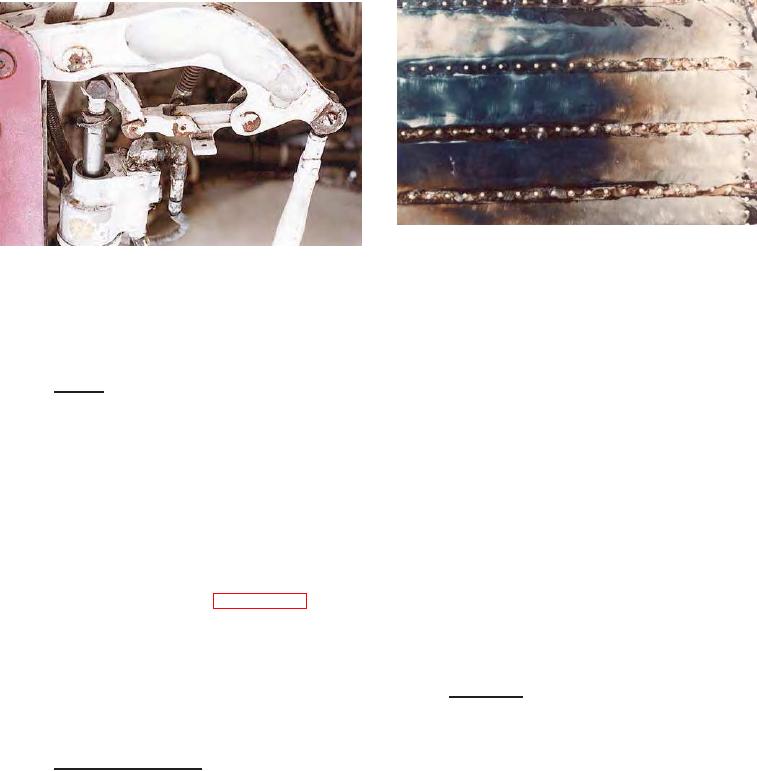
01 March 2005
NAVAIR 01-1A-509-1
TM 1-1500-344-23-1
TO 1-1-689-1
Figure 3-26. Color Changes in Titanium Due to Heating
Figure 3-25. Steel Corrosion Products
passive layer, on the surface of these alloys. Corrosion
of this type are thicker than those applied by immersion
and heat resistance are the major factors in selecting
or brush on conversion coating. Anodized finishes cannot
stainless steels for a specific application. However, it
be restored in the field. Care should be taken to minimize
should be well understood that stainless steels are not
removal of these coatings.
the cure-all for all corrosion problems, due to service
conditions which can destroy the oxide film on their
3-10.4. STEEL. Ferrous (iron) alloys are used to
surfaces. Stainless steels are susceptible to crevice
manufacture many aircraft components and massive
corrosion and stress corrosion cracking in moist, salt
structures and assemblies in aircraft ground support
laden environments. Exposure to saltwater can cause
equipment, such as missile gantries, silo crib structures,
pitting. The corrosion product of stainless steel is a
frames and bodies of trailers and vans, and lesser
roughened surface with a red, brown, or black stain.
structural parts such as brackets, racks, and panels.
Corrosion treatment of stainless steel should be limited
Iron and steel are also used as component leads,
to cleaning. Stainless steels can cause galvanic
magnetic shields, transformer cores, brackets, racks,
corrosion of almost any other metal with which they are
and general hardware in avionic systems. If unprotected,
in contact if proper techniques of sealing and protective
ferrous alloy surfaces (with the exception of stainless
coating are not used. Stainless steels may be magnetic
steels) are easily corroded in the presence of moisture.
or non-magnetic. The magnetic steels are identified by
Corrosion of steel is easily recognized because the
numbers in the American Iron and Steel Institute (AISI)
corrosion product is red rust (Figure 3-25). When
400 Series (e.g. 410, 430). These steels are not as
ferrous alloys corrode, a dark corrosion product usually
corrosion resistant as the non-magnetic steels, which
forms first. When moisture is present, this coating is
are identified by numbers in the AISI 300 Series (e.g.
converted to red rust, which promotes further attack by
304, 316).
absorbing moisture from the air. Ferrous alloy surfaces
of structures or assemblies are normally painted, or
3-10.6. TITANIUM. Titanium and titanium alloys find
plated with nickel, tin, or cadmium and painted, to
numerous uses in aircraft, engines, and missiles at
prevent corrosion.
temperatures up to 1000F (540C). Above 1000F,
titanium readily absorbs gases from the surrounding air
3-10.5. STAINLESS STEEL. Stainless steels, or
and becomes very brittle. Under certain conditions,
chlorides and some chlorinated solvents may induce
corrosion resistant steels (as they are more properly
stress corrosion cracking of certain titanium alloys.
described) are alloys of iron containing large amounts
Titanium and its alloys are highly corrosion resistant. An
of chromium and nickel. Stainless steels are used for
oxide film forms on their surfaces almost immediately
upon contact with air, which is extremely adherent to
mountings, racks, brackets, and hardware in avionic
the surfaces and provides a protective barrier. This is
systems. The main reason for the existence of stainless
identical to the way aluminum forms a protective oxide
steels is their resistance to corrosion. Stainless steels
film on its surface. Even at temperatures approaching
are much more resistant to common rusting, chemical
1000F, titanium retains its strength and corrosion
action, and high temperature oxidation than ordinary
resistance. When titanium is heated, oxides having
steels, due to the formation of an invisible oxide film, or

